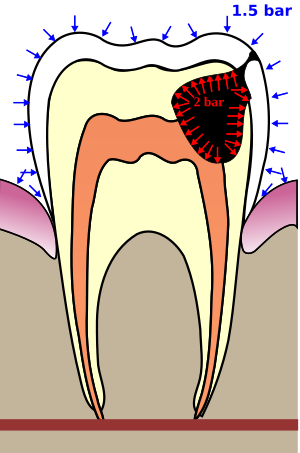The Tooth Fairy is a fantasy figure of early childhood in Western and Western-influenced cultures.[1] The folklore states that when children lose one of their baby teeth, they should place it underneath their pillow or on their bedside table and the Tooth Fairy will visit while they sleep, replacing the lost tooth with a small payment.[2]
https://en.wikipedia.org/wiki/Tooth_fairy
Origins
In Northern Europe, there was a tradition of tand-fé or tooth fee, which was paid when a child lost their first tooth.[3] This tradition is recorded in writings as early as the Eddas (c. 1200), which are the earliest written record of Norse and Northern European traditions. In the Norse culture, children's teeth and other articles belonging to children were said to bring good luck in battle, and Scandinavian warriors hung children's teeth on a string around their necks.
During the Middle Ages, other superstitions arose surrounding children's teeth. In England, for example, children were instructed to burn their baby teeth to save the child from hardship in the afterlife. Children who did not consign their baby teeth to the fire would spend eternity searching for them in the afterlife. The Vikings paid children for their teeth. Fear of witches was another reason to bury or burn teeth. In medieval Europe, it was thought that if a witch were to get hold of one's teeth, it could lead to total power over them.[4]
Another modern incarnation of these traditions into an actual Tooth Fairy has been traced to a 1908 "Household Hints" item in the Chicago Daily Tribune:
Tooth Fairy. Many a refractory child will allow a loose tooth to be removed if he knows about the Tooth Fairy. If he takes his little tooth and puts it under the pillow when he goes to bed the Tooth Fairy will come in the night and take it away, and in its place will leave some little gift. It is a nice plan for mothers to visit the 5-cent counter and lay in a supply of articles to be used on such occasions.[5]
— Lillian Brown, Tooth Fairy, Chicago Daily Tribune
https://en.wikipedia.org/wiki/Tooth_fairy
Pedicellate teeth are a tooth morphology today unique to modern amphibians, but also seen in a variety of extinct labyrinthodonts. Pedicellate teeth consist of a tooth crown and a base (both composed of dentine) separated by a layer of uncalcified dentine.
Further reading
- Greven, Hartmut (1989). "Teeth of extant amphibia: morphology and some implications". Progress in Zoology. 35: 451–455.
- Davit-Béal, Tiphaine; Chisaka, Hideki; Delgado, Sidney; Sire, Jean-Yves (2007). "Amphibian teeth: current knowledge, unanswered questions, and some directions for future research". Biological Reviews. 82 (1): 49–81. doi:10.1111/j.1469-185X.2006.00003.x. PMID 17313524. S2CID 9251659.
External links
https://en.wikipedia.org/wiki/Pedicellate_teeth
Father Christmas is the traditional English name for the personification of Christmas. Although now known as a Christmas gift-bringer, and typically considered to be synonymous with Santa Claus, he was originally part of a much older and unrelated English folkloric tradition. The recognisably modern figure of the English Father Christmas developed in the late Victorian period, but Christmas had been personified for centuries before then.[1]
https://en.wikipedia.org/wiki/Father_Christmas
The Easter Bunny (also called the Easter Rabbit or Easter Hare) is a folkloric figure and symbol of Easter, depicted as a rabbit—sometimes dressed with clothes—bringing Easter eggs. Originating among German Lutherans, the "Easter Hare" originally played the role of a judge, evaluating whether children were good or disobedient in behavior at the start of the season of Eastertide,[1] similar to the "naughty or nice" list made by Santa Claus. As part of the legend, the creature carries colored eggs in its basket, as well as candy, and sometimes toys, to the homes of children. As such, the Easter Bunny again shows similarities to Santa (or the Christkind) and Christmas by bringing gifts to children on the night before a holiday. The custom was first[2][unreliable source?] mentioned in Georg Franck von Franckenau's De ovis paschalibus[3] ('About Easter eggs') in 1682, referring to a German tradition of an Easter Hare bringing eggs for the children.
https://en.wikipedia.org/wiki/Easter_Bunny
Eggs have been used as fertility symbols since antiquity.[9]
https://en.wikipedia.org/wiki/Easter_Bunny
| Barodontalgia | |
|---|---|
| Other names | Aerodontalgia, dental barotrauma |
 | |
| Specialty | Hyperbaric medicine |
Barodontalgia, commonly known as tooth squeeze, is a pain in a tooth caused by a change in ambient pressure. The pain usually ceases at ground level.[1][2][3] Dental barotrauma is a condition in which such changes in barometric pressure changes cause damage to the dentition.
https://en.wikipedia.org/wiki/Barodontalgia
https://en.wikipedia.org/wiki/Category:Fossil_taxa_described_in_1976
https://en.wikipedia.org/wiki/Batodonoides
https://en.wikipedia.org/wiki/Vaccinium_arboreum
No comments:
Post a Comment